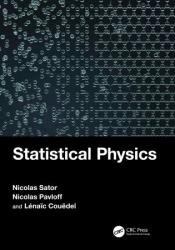 Название: Statistical Physics
Название: Statistical PhysicsАвтор: Nicolas Sator, Nicolas Pavloff, Lenaic Couedel
Издательство: CRC Press
Год: 2024
Страниц: 451
Язык: английский
Формат: pdf (true)
Размер: 13.8 MB
This book presents an introduction to the main concepts of statistical physics, followed by applications to specific problems and more advanced concepts, selected for their pedagogical or practical interest. Particular attention has been devoted to the presentation of the fundamental aspects, including the foundations of statistical physics, as well as to the discussion of important physical examples. Comparison of theoretical results with the relevant experimental data (with illustrative curves) is present through the entire textbook. This aspect is facilitated by the broad range of phenomena pertaining to statistical physics, providing example issues from domains as varied as the physics of classical and quantum liquids, condensed matter, liquid crystals, magnetic systems, astrophysics, atomic and molecular physics, superconductivity and many more. This textbook is intended for graduate students (MSc and PhD) and for those teaching introductory or advanced courses on statistical physics.
When all the degrees of freedom of a system are described by quantum mechanics, one resorts to statistical quantum physics, introduced in Chapter 6. Particles’ spins play a fundamental role and have major effects on all the physical properties of a system. In addition to the quantisation of physical quantities and the discretisation of microstates, another manifestation of quantum physics is the indistinguishability of identical particles (i.e. same mass, charge and spin): one cannot assign an individual state (specified by quantum numbers) to each of them, nor even a label (e.g. a number). Only the collective states of N particles have physical meaning. Thus, the microstate of a quantum gas composed of N identical particles is described by 3N quantum numbers (if one ignores the spin), while each particle cannot be assigned an individual set of three quantum numbers. In contrast, in classical statistical physics, each particle has its own position and momentum. The use of classical statistical physics does not preclude some internal degrees of freedom being described using quantum physics. For example, since the atoms of a crystal are located at the nodes of the lattice, their equilibrium positions can be considered fixed (classical description). Thus, atoms behave as discernible particles with an assigned equilibrium position and therefore are identifiable. Then, the atoms’ oscillations around their equilibrium positions can be studied using a classical or quantum description11. The spin degrees of freedom are necessarily described by quantum mechanics.
Key Features:
A rigorous and educational approach of statistical physics illustrated with concrete examples.
A clear presentation of fundamental aspects of statistical physics.
Many exercises with detailed solutions.
Скачать Statistical Physics